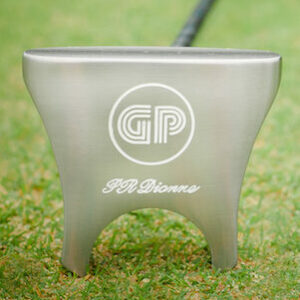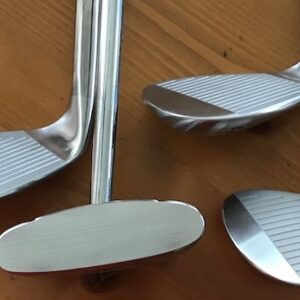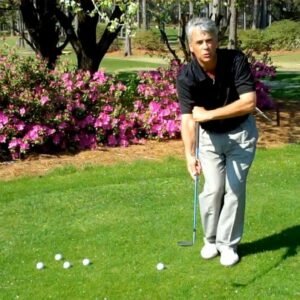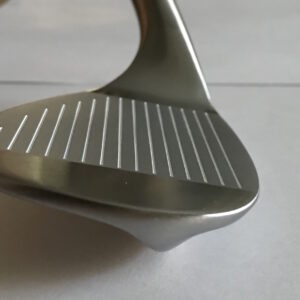Mastering the Optimal Basic Setup for the GP Putter
The Very Simple and Natural Basic Setup for Face-On Putting.
It’s simple in that it requires far fewer moving parts than a tradition golfing movement. Also, when Face-on-Putting, the Club Face stays pointed down the target line throughout the entire putt. That’s FAR simpler than the “open door / closed door” technique that’s used in traditional putting. Furthermore, it’s VERY easy to swing the putter “straight back and straight through” with the GP putter.
The side saddle putting is 100% legal for any golf tournament in the world. Putting face-on with the GP putter is 100% legal in any golf tournament. The putting stroke (technique) that you see in the videos is again 100% legal.
Master Your Short Putts: Using Two Putters, including the GP Putter, for Lower Scores
Putting can be a make-or-break aspect of golf, and short putts can be particularly challenging. Did you know that even professional golfers on the PGA Tour only succeed in sinking about 50% of their putts from 8 feet? If you’re looking to improve your putting game, consider incorporating a two-putter strategy, including the GP Putter, for putts inside 20 feet.
Using the GP Putter for short putts can lead to quick and noticeable improvements in your putting game. With practice, you can become proficient at sinking putts from inside 20 feet, building your confidence and lowering your scores. The GP Putter’s user-friendly design makes it easy to align and square the putter face to the target, reducing the risk of misalignment-related missed putts. This can help you gain a competitive edge, especially during tournament play, where every stroke counts.
But what about longer putts beyond 20 feet? While the GP Putter is highly effective for short putts, it may take more practice to develop the same level of proficiency for longer putts. That’s where your other putter comes into play. By using your current putter for longer putts, you can maintain your distance control and feel for longer distances while relying on the GP Putter for the critical short putts.
Incorporating a two-putter strategy can be a game-changer for your overall putting performance. By mastering short putts with the GP Putter and using your other putter for longer putts, you can optimize your chances of sinking putts from all distances and ultimately lower your scores. With putting accounting for a significant portion of your score, it’s worth the investment of time and effort to improve this crucial aspect of your golf game.
In conclusion, using a two-putter strategy that includes the GP Putter for putts inside 20 feet can be a game-changer for your putting game. Its specialized design promotes a more natural and consistent stroke, improves alignment, and boosts confidence, all of which can lead to more successful putts and improved scores. You have a total of 14 clubs in your golf bag and 13 clubs for 60% of your scores so if you don’t use all 13 golf clubs maybe time to replace one with the GP putter until you succeed laging your putts with the GP putter. Elevate your putting success and take your golf game to the next level with the GP Putter.
The fastest and easiest way to reduce your golf score is to improve your putting.
You can shave more strokes off each round through good putting than if you learned to drive the ball 300 yards down the middle of the fairway like the pro’s do. Of course you will still want to continue to improve the other parts of your game in addition to your putting.
Let’s face it: The pro’s who know how to putt are the ones who win the TOP money. A pro will spend a large percentage of his practice time on the putting green and around the putting green — NOT the driving range! (But for most golfers, it’s the other way around.)
Make putting the best and most enjoyable part of your game. All you need is to practice a little bit and you will see the big improvement in your game.
How to avoid a three putts and get better a lagging your putts. We recommend to practice 90% of your time from inside 10 feet of the hole. The reasoning for this logical practice is that most of your three putt that you have is because you miss your second putt from inside 10 feet. So the better your are from that distance the easy to place the golf ball inside that circle of 10 feet from a long distance. If you are at 60 feet away from the hole you have a better chance to lag your putt in a big circle of 12 feet (you could be short or pass the hole by 6 feet because you are very good from inside 10 feet so you just reduce the anxiety of that putt. The face on putting technique with the GP putter is like tossing the ball with your hand to the hole. Just think if I give you the ball in your hand and ask you to toss it to the hole how easier it would be. The GP putter face on putting technique emulate the tossing motion with your hand.
Putting Rules
Explanation of the putting rules for the face on putting stroke. The USGA had banned croquet-style putting “between the legs” and also standing on extension of Line of the putt. But if you stand next to the line of your putt it’s 100% legal that way. The face on putting style that you see with the GP putter is again 100% legal for any golf tournament in the world. You can find the rules of golf on the USGA website.
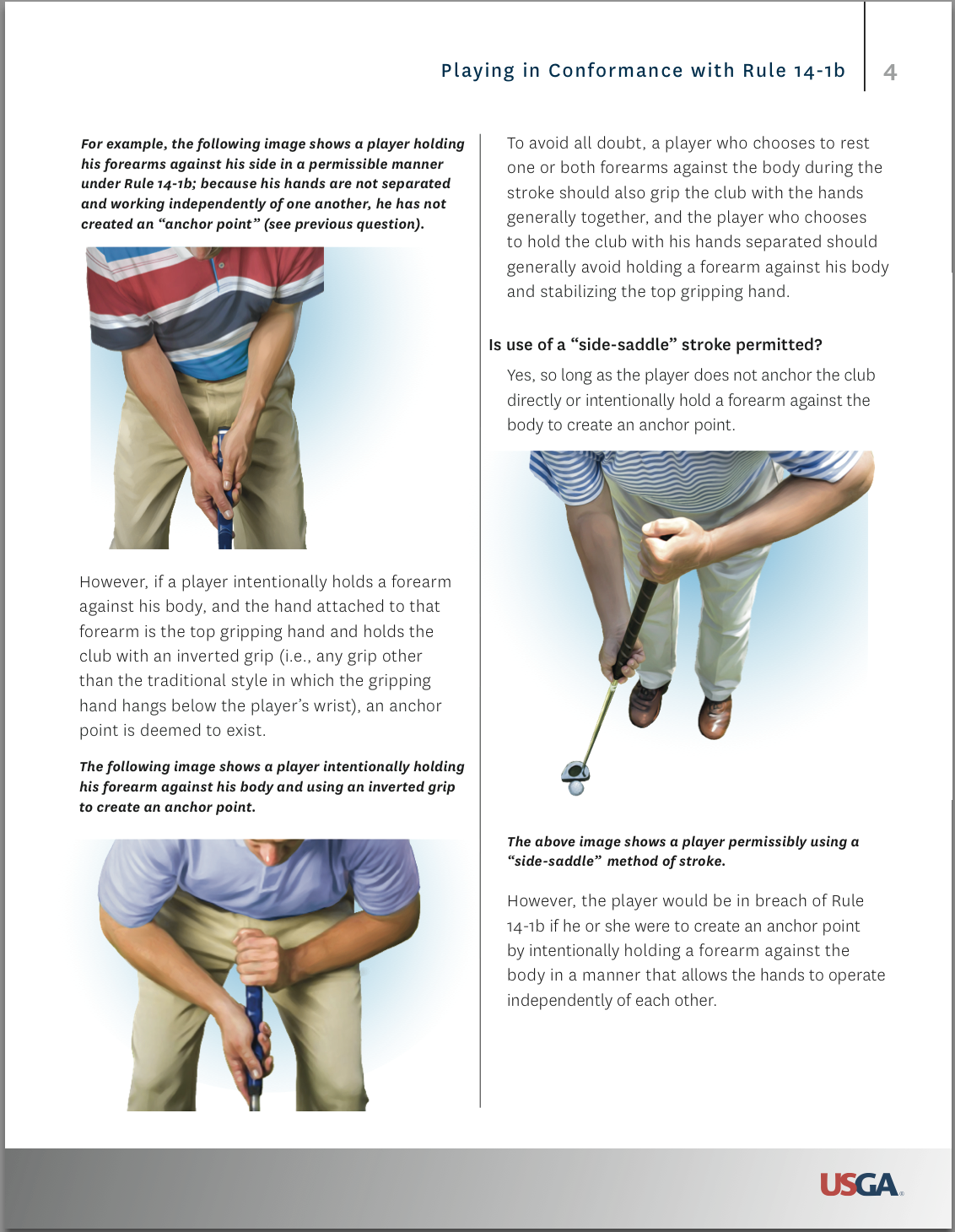
Welcome to our video tutorial on Face on Putting in golf. This unconventional and alternate putting technique offers a different approach to the traditional style and is gaining popularity among golfers looking to improve their game.
In this video, we will cover the key aspects of side saddle putting, including the proper technique, posture, and grip. We will also delve into the importance of aim and alignment, balance and stability, and how to achieve better control and accuracy on the greens.
We’ll provide tips and drills for visualizing your shots, increasing your confidence, and refining your mental approach. And, of course, we will show you how to improve your green reading, speed control, distance control, and follow through to maximize your results.
Whether you’re an experienced golfer or just starting out, this video tutorial on side saddle putting will provide valuable lessons and insights to help you perfect your technique and take your putting game to the next level. Join us now and start your journey to a more confident, consistent, and successful putting style with face on putting.
Putting is one of the most crucial aspects of the game of golf.
When it comes to putting, there are many different techniques and approaches that golfers use to try and sink their putts. One approach that has become increasingly popular in recent years is putting facing the target. In this article, we will explore why you need to putt facing the target in golf.
Firstly, putting facing the target can help you line up your putts more accurately. When you stand with your body facing the target, your eyes are in a better position to see the line of the putt. This allows you to align your putter head more accurately with the target, which can lead to more putts being holed.
Secondly, putting facing the target can help you stay more balanced throughout your putting stroke. When you stand perpendicular to the target, it can be challenging to maintain your balance throughout the stroke. By facing the target, you can keep your weight centered and maintain a more stable base, which can help you make more consistent strokes.
Thirdly, putting facing the target can help you make a more natural putting stroke. When you stand perpendicular to the target, you may be more likely to manipulate the putter in an effort to control the direction of the putt. This can lead to an unnatural putting stroke, which can be less effective. By facing the target, you can make a more natural, pendulum-like putting stroke, which can lead to better results on the green.
Finally, putting facing the target can help you build more confidence in your putting game. By using this technique and seeing positive results, you can develop more trust in your putting stroke and become more confident in your ability to sink putts.
In conclusion, putting facing the target can be a highly effective technique for golfers looking to improve their putting game. It can help you line up your putts more accurately, stay balanced throughout your stroke, make a more natural putting stroke, and build more confidence in your putting ability. Whether you are a beginner or an experienced golfer, this technique is definitely worth trying out to see if it can help you improve your putting game.
Understanding the Critical Role of Basic Setup in Lag Putting in Golf
It refers to the ability to hit a putt at the correct speed and distance, leaving yourself with an easy tap-in for par or birdie. However, lag putting is not always easy, especially on fast and undulating greens. Therefore, it is essential to practice lag putting to improve your overall golf game. In this article, we will discuss some effective lag putting drills that can help you improve your putting skills.
- Long Distance Putting Challenge One of the most effective ways to practice lag putting is by setting up a long-distance putting challenge. Choose a spot on the putting green, about 50 feet away from the hole. Use a few markers or cones to create a target area around the hole. The objective of the challenge is to try and hit as many putts as possible within the target area. The key to this drill is to focus on distance control, and not worry too much about accuracy. This drill can help you develop a better feel for the green and improve your lag putting skills.
- Uphill and Downhill Putting Uphill and downhill putts can be challenging to judge, and therefore, they require a specific type of practice. Set up two cones or markers, one uphill and one downhill, about 25 feet away from the hole. Start by hitting putts uphill, focusing on getting the ball to the top of the hill. Then switch to hitting putts downhill, trying to leave the ball short of the hole. This drill can help you develop a better sense of how to adjust your stroke for uphill and downhill putts.
- Clock Drill The clock drill is a simple and effective way to practice lag putting from different distances. Start by placing five balls around the hole, at 3, 6, 9, and 12 o’clock positions, as well as a ball directly behind the hole. Hit putts from each of these positions, focusing on getting the ball to stop as close to the hole as possible. This drill can help you develop a better sense of distance control from various angles.
In conclusion, practicing lag putting is an essential part of improving your golf game. By using these effective lag putting drills, you can develop better feel, touch, and distance control around the greens. Whether you are a beginner or an experienced golfer, these drills can help you improve your putting skills and lower your scores on the golf course.
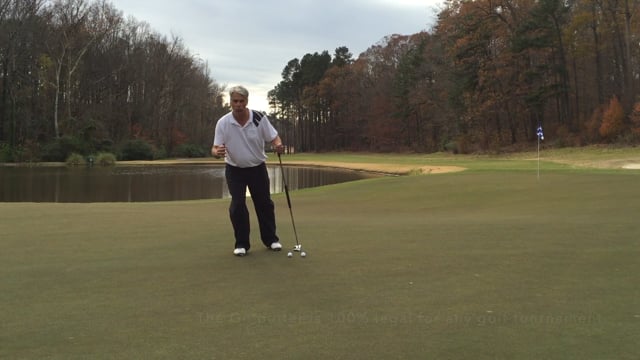


If you find that your putting technique is posing challenges and causing difficulties in your golf game, opting for a straightforward putting style might be an advantageous solution. Simplifying your putting approach, focusing on fundamental mechanics, and reducing any unnecessary complexities could significantly improve your consistency and accuracy on the greens. Emphasizing a more direct and uncomplicated method in your putting technique could prove beneficial, especially when struggling with the intricacies or inconsistencies in your current approach.
